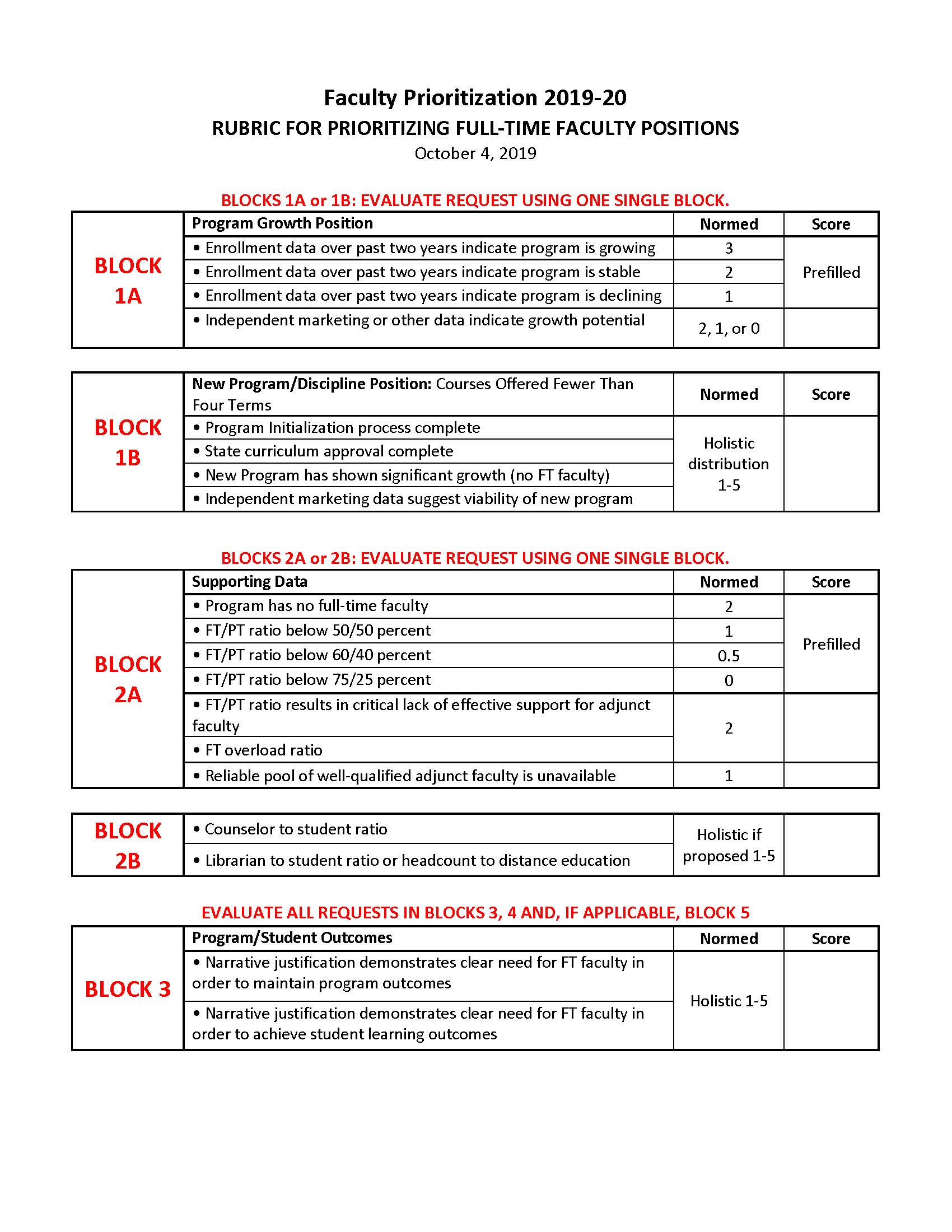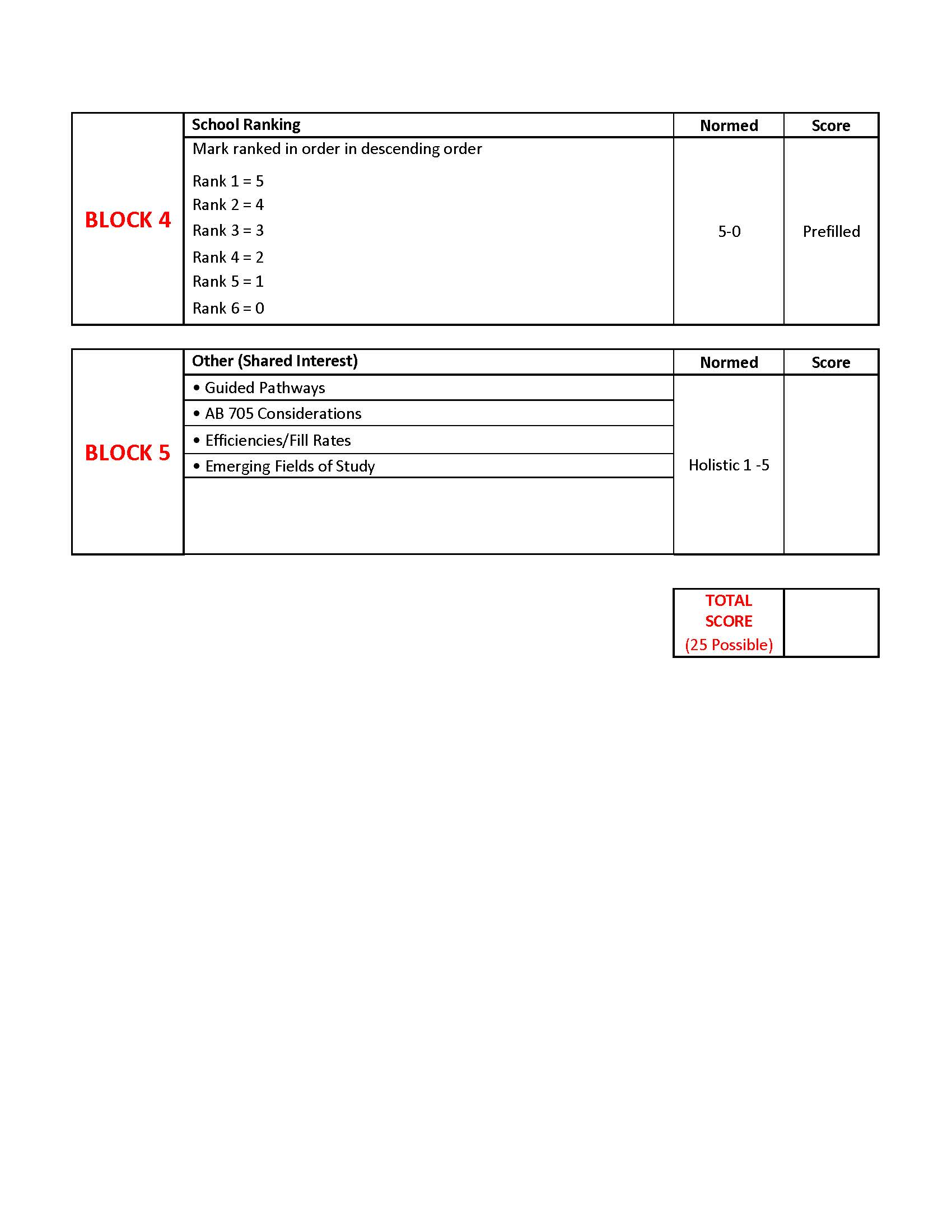Appendix I
Faculty Prioritization Process
Revised and approved by the Academic Senate (10-26-17) and College Planning Council (10-27-17).
General:
-
Faculty positions requested through the Program Enhancement Plan Update (PEP-Up) and Program Review Update (PRU) will be identified as being funded by either:
-
unrestricted funds
-
categorical funds
-
grant funds
-
Categorical funded faculty positions that are identified in a Plan that has been approved by the District and the Academic Senate need not be ranked through the prioritization process as the institution has already determined, via the approved plan, the need for such position.
-
Grant-funded positions that are identified in a grant application that has been approved by the District and the Academic Senate need not be ranked through the prioritization process as the institution has already determined, via the approved grant application, the need for such position.
-
Replacement request due to tenure track attrition is filled automatically unless extenuating circumstances exist.
-
Tenured faculty departures shall be replaced. The replacement may be set aside, temporarily or permanently, if compelling circumstances exist. (See Process, step 13.)
-
If the replacement is set aside temporarily (due to fiscal constraints or other institutional needs as determined by the superintendent/president) that position shall be hired in the next hiring cycle unless extenuating circumstances exist. (See Process, step 13.)
-
In the case of an unexpected departure of a tenured faculty, the use of the Faculty Emergency Hire Procedure will be initiated immediately.
-
Faculty positions identified in B, C, D, E, and F above do not need prioritization ranking. They will be included in the prioritization list for informational purposes.
Membership of the Prioritization Committee (16 Voting, 1 Non-Voting):
-
Eight (8) leadership appointed by the Superintendent/President
-
One (1) leadership member to be appointed the Administrative Co-Chair by the Superintendent/President
-
Eight (8) Faculty appointed by the Academic Senate (with desired membership from Outcomes and Assessment Committee)
-
Five (5) instructional faculty (one from each school)
-
One (1) student services faculty
-
One (1) library or distance education faculty
-
One (1) Academic Senate President (Faculty Co-Chair)
-
One (1) Outcomes and Assessment Committee Chair or designee (ex-officio non-voting) for input/expertise
Process:
-
Each academic year, as part of the Program Review Update (PRU)/Program Enhancement Plan Update (PEP-Up) process, Department Chairs/Area Coordinators/Discipline Faculty will have the opportunity to fill out a Faculty Position Request Form, providing relevant data and a narrative justifying the need for a fulltime position.
-
All Program Enhancement Plan Updates will be uploaded to the Outcomes and Assessment webpage by the Outcomes and Assessment Committee (OAC) representatives. All Program Review Updates will be uploaded to the Institutional Effectiveness and Planning webpage by the Office of Institutional Effectiveness.
-
The faculty request forms will be extracted from the PRU by the Office of Institutional Effectiveness and prepared for the Prioritization Committee.
-
Faculty requests for new programs (those not yet in existence) may be submitted via the faculty request form by the appropriate dean or faculty member, directly to the OAC.
-
The Budget Sub-Committee will communicate an estimate of the number of positions funded with unrestricted funds no later than October 15th.
-
The prioritization committee will rank 150% of the estimated number of positions funded with unrestricted funds.
-
The data required on the Faculty Request forms and the criteria used for ranking on the Prioritization Rubric will be articulated and revised as necessary by joint agreement of the OAC, the Academic Senate, and the College Planning Council.
-
Each year, prior to the evaluation of the faculty position requests, members of the Prioritization Committee will be trained (normed) in using the criteria on the Prioritization Rubric. Data will be used as much as possible in evaluating the requests, but as every program is different, many factors must be considered. Not all criteria are hierarchal in nature.
-
The Prioritization Committee will review the data from the Faculty Request forms and will evaluate each request on the basis of the specified criteria (See Prioritization Rubric and Directions). The Co-Chairs of the Faculty Prioritization Committee are voting members.
-
In the event that the Prioritization Committee needs more information, the co-chairs of the committee may ask for a representative from the department in question to come forward to answer questions about the position; however, no presentations will be made.
-
The initial ranking will be done by ballot as follows: each member will assign a score to each rubric category for each position request. The total of the average scores in each rubric category will determine the initial ranking. The initial ranking may be revised as described in (13) below.
-
Once the draft list has been completed, any member of the Faculty Prioritization Committee can suggest an override of a ranking. Overrides are permitted when a supermajority (8/12 of the committee members are required) votes to re-rank a single position. In positions 1-5, a position may be moved one slot up or down; in positions 6-10, a position may be moved two slots up or down; in positions 11-20, a position may be moved three slots up or down.
-
Once a prioritization/replacement list is completed, it will be presented to the college president, the Academic Senate, Budget Planning Committee, and the College Planning Council. Should the president override any of the ranked/replacement positions, he or she must present a detailed written explanation of that decision to the Academic Senate and to the College Planning Council within one month.
-
The timeline shown below is for the typical prioritization and faculty hiring cycle. The process will also apply to out of cycle faculty requests.
-
Requests shall be campus and site-specific. In the case of a failed search, a new search will proceed automatically.
Timeline:
-
By March 15
-
Faculty, Deans, and Area Coordinators fill out faculty request forms as part of the Program Enhancement Plan Update or Program Review Update.
-
Fall
-
Faculty Prioritization Committee evaluates and ranks the requests using the Prioritization Rubric. The ranked list is forwarded to the President, the Budget Planning Committee, and to the Academic Senate.
-
January through February
-
President announces the number of positions to be funded for the next academic year. HR initiates the process for faculty hiring.
-
Faculty Prioritization Committee reconvenes, debriefs, and evaluates the process (in order to improve it).
-
March
-
Screening committees review applications.
-
April through May
-
Candidates interviewed; finalists selected.
-
May through June
-
Board of Trustees approves contracts
Directions for Using the Rubric:
-
Prior to the Full-Time Faculty Prioritization meeting, each Co-Chair will be tasked with determining three interests.
-
During the Full-Time Faculty Prioritization meeting, the group may decide upon a single shared interest that will be scored under the category “Other.” This category will allow the committee to incorporate criteria not covered elsewhere in the Rubric. Possible examples of shared interest are:
-
The District has made a commitment to build a Center in the west valley and a Full-time faculty member dedicated to this location is needed.
-
The position is needed to address a demonstrable gap in student success among student veterans.
-
All faculty requests will fall into either Block 1A or 1B on the rubric: Growth Positions (for established programs requesting additional FT faculty); New Program/Discipline Position (for programs/disciplines not yet established or newly established with no full-time faculty).
-
Within the appropriate block, each request will be assigned 0-5 points based on the criteria listed.
-
All requests will be evaluated in Blocks two, three, and four, and if applicable, Block five. In each of these blocks, each request will be assigned 0-5 based on the criteria listed.
-
Note: Not all criteria within a block are hierarchal in nature. Requests must be evaluated holistically within each block, based on a variety of factors.
-
The positions will then be ranked in order of the total points earned. In the case of ties, the committee will vote to rank the positions; a simple majority is all that is required for this procedure.



